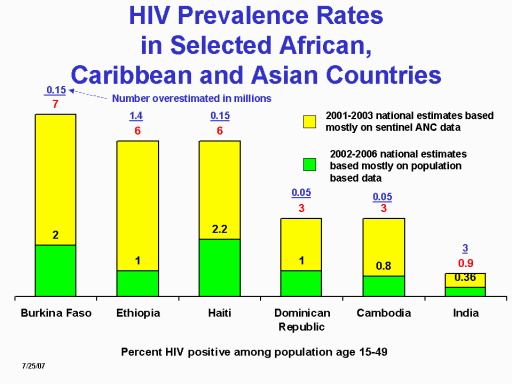| front |1 |2 |3 |4 |5 |6 |7 |8 |9 |10 |11 |12 |13 |14 |15 |16 |17 |18 |19 |20 |21 |22 |23 |24 |25 |26 |27 |28 |29 |30 |31 |32 |33 |review |
 |
This
figure shows the reduction in HIV prevalence estimates in six
countries that UNAIDS was forced to accept based on more accurate
population based HIV surveys.
The total difference between these estimates of close to 5 million
is mostly due to overestimation using biased and unrepresentative
urban antenatal clinic data, but some of the decrease may be due to
a natural decline in HIV prevalence since most of these countries
have been in the post peak phase of their HIV epidemics.
In July 2007, UNAIDS was forced to acknowledge that HIV
prevalence in India was less than 2.5 million and not close to 6
million as UNAIDS had estimated in the previous year.
A UNAIDS
spokesperson has said that the new calculation for India reduces the world
estimate [of HIV-infected persons] to about 37.5 million people and that
UNAIDS does not expect any more revisions from countries with major HIV and
AIDS epidemics since “India was the last unknown.”
As of 2007,
there are about 50 countries where HIV prevalence has been estimated to be
more than 1% of the adult population. More than half of these countries have
had their HIV prevalence estimate based on the flawed method that relies on
“sentinel surveillance sampling” of mostly urban antenatal clinics (ANC):
these biased and unrepresentative ANC data were then extrapolated to the
total national adult population – urban and rural!
So how can UNAIDS be so confident that there will not be any more HIV
prevalence reductions from countries that continue to rely on this flawed
method?
|